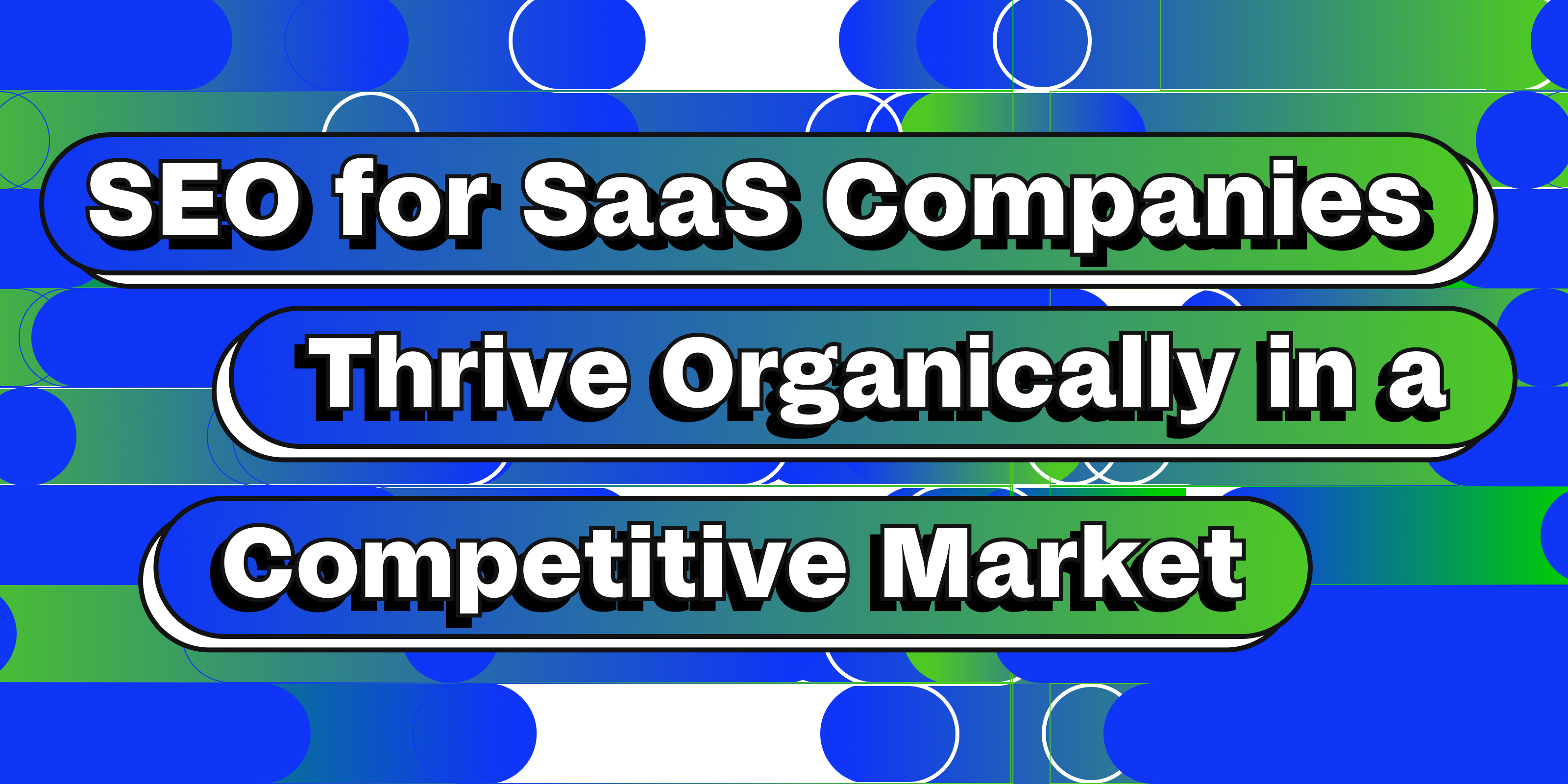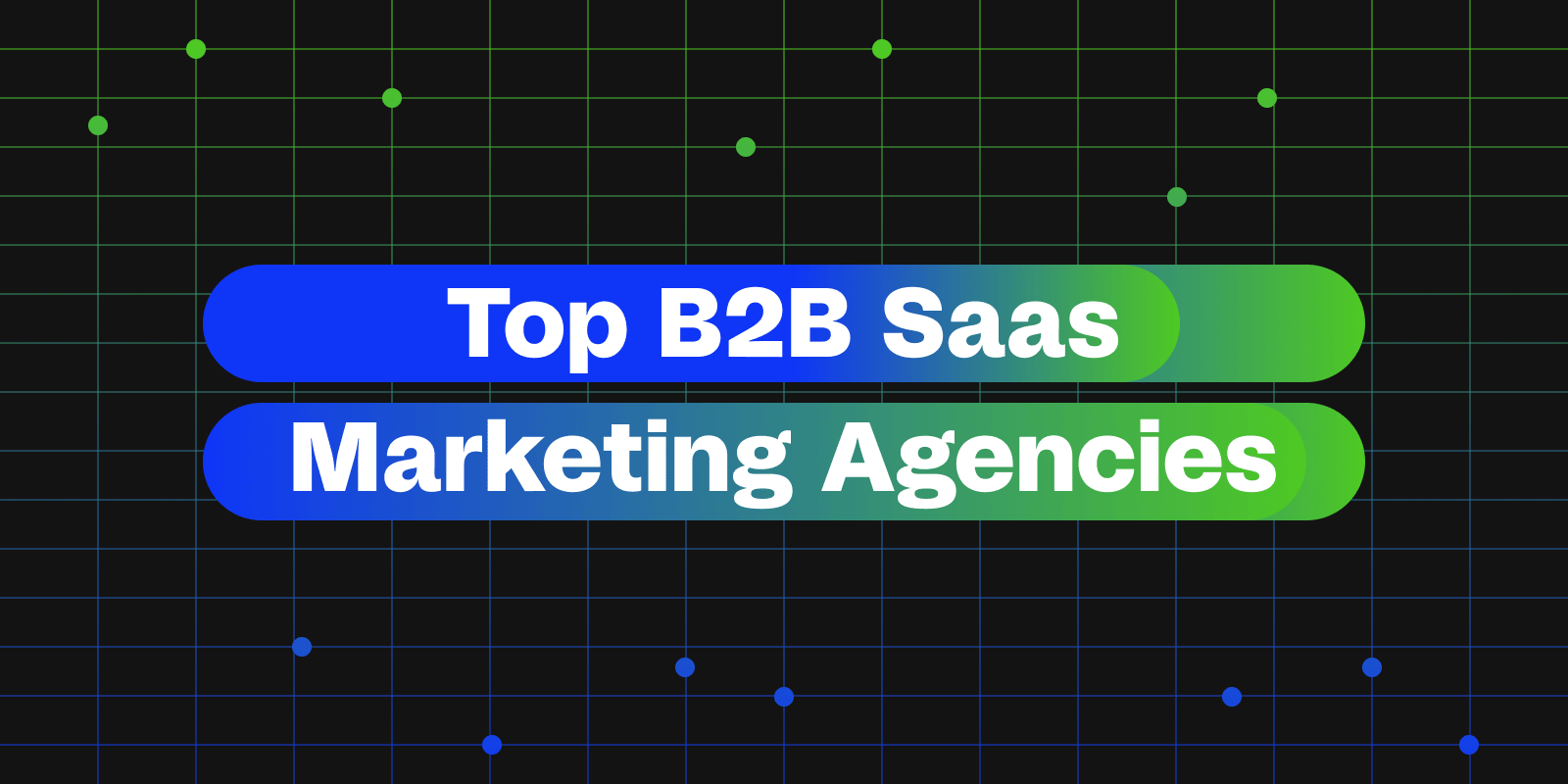There are 4 billion active email users and 437 billion emails being sent and received each day. For the SaaS industry specifically, companies report a 66% average open rate for their targeted email marketing campaigns — a testament to the effectiveness of using email marketing for reaching potential customers and driving conversions. Its direct and personalized approach enables SaaS businesses to nurture leads, guide new user onboarding, and maintain consistent communication to retain existing customers. With targeted campaigns, SaaS brands can effectively educate users about updates, offer valuable insights, and incentivize key actions like sign-ups, renewals, or upgrades.
What is email marketing for SaaS?
Email marketing for SaaS is the practice of using email as a channel to promote SaaS (software-as-a-service) products to potential and existing customers. For potential customers, email marketing for SaaS serves to highlight the benefits of the product, educate the user, and hopefully convert them into paying customers through a sign-up flow. For existing customers, email marketing for SaaS aims to foster retention and loyalty through regular product updates, limited-time offers, educational content, and more.
What makes email marketing for SaaS so different?
Email marketing is a channel commonly used across a wide variety of industries, including but not limited to eCommerce, healthcare, financial services, and more. That being said, email marketing for SaaS is unique in its heavy reliance on user data, entire customer journey, and ever-evolving product, making it a more challenging — but also more impactful — channel for SaaS companies to focus on.
As an example, let’s compare email marketing for SaaS to email marketing for eCommerce. Most e-commerce companies have a list of leads to whom they send targeted communications, whether it be in the form of discounts, product drops, or recommendations, in order to drive them to make a purchase. As soon as the lead purchases a product, the job is (mostly) done. Granted, email marketing for eCommerce still includes initiatives like post-purchase follow-ups, feedback collection, and loyalty programs to encourage additional future purchases, but in the most simple sense, the end goal is always to drive a purchase.
Email marketing for SaaS, on the other hand, has less of a clear end goal. In fact, there is never truly an end goal that is reached, because the SaaS business model requires constant subscription renewals in order to maintain a consistent revenue stream. The task then becomes much more than just converting a lead to a user — it’s also about educating the user on how to use the product, helping them continuously derive value from the software, and nurture the relationship throughout their entire product journey.
In an ideal world, a successful SaaS product will be one that is constantly improving its functionalities based on user feedback and behavioral data, and will utilize user data to personalize the product experience to optimize the amount of value it can provide to the paying user. This standard of success poses an additional expectation for SaaS companies to send highly personalized and constantly up-to-date product information based on every user’s place in their individual product journey.
Types of SaaS models
There are 2 main types of SaaS models, and knowing the difference between each of them is crucial to determining the type of strategy or email that would be effective in converting and nurturing qualified customers. The two types of SaaS models are the free trial model and the freemium model.
The free trial model
The free trial model allows each potential customer to have full access to the SaaS product for a limited period of time (typically 30 days). As their free trial is starting to expire, users are typically urged to create a paying account in order to maintain their service with no interruptions. Common email marketing touchpoints for the free trial model include trial expiration notifications, upgrade reminders, and post-trial feedback collection.
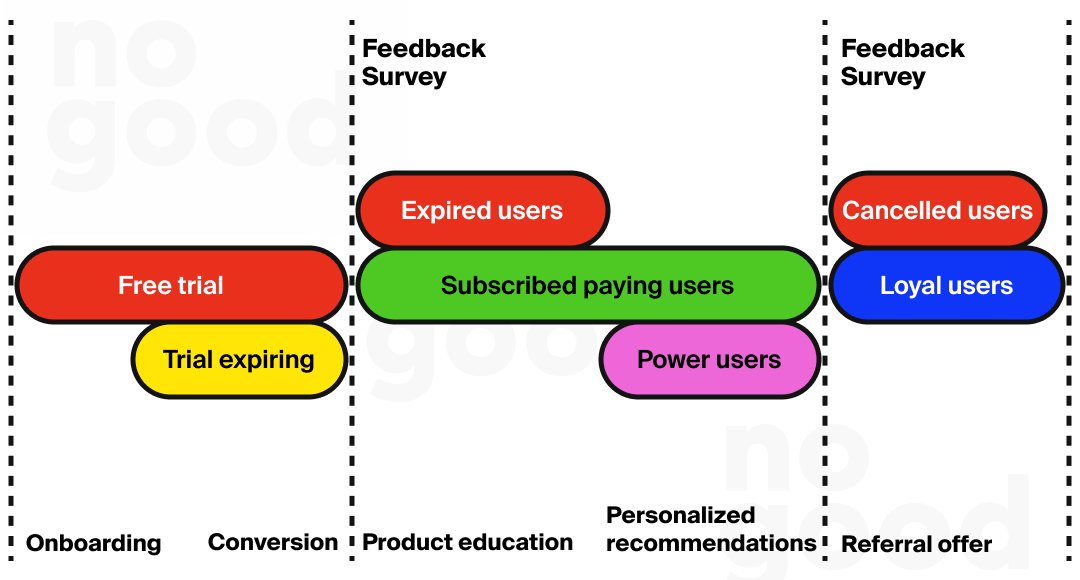
The freemium model
The freemium model allows users to have free access to a limited number of basic features within the SaaS product. In order to unlock greater functionality or more advanced features, users can choose to upgrade to a paying subscription. In some cases, paying subscriptions are separated into multiple tiers of different price and access levels, to allow users to choose the option that best suits their needs. Common email marketing touchpoints for the free trial model include upgrade recommendations, feature highlights, and feedback collection.
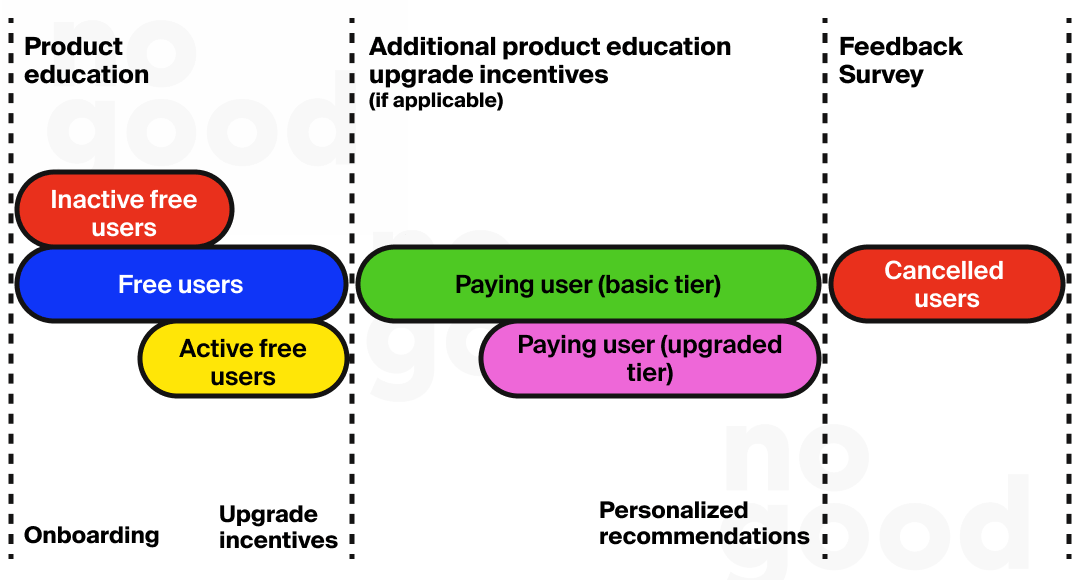
Looking for a SaaS marketing agency?
Types of SaaS emails (with examples)
There are many different types of SaaS emails, each of which serves a different purpose at a different point in a user’s journey. In order to determine which emails you should send at which touchpoint, start by mapping out the entire user journey from awareness to conversion to retention, then understand the key actions that may happen at each stage of the journey. Note that these key actions include negative or undesirable actions too, such as unsubscriptions, expirations or cancellations, which are still useful touchpoints for follow-up or feedback collection emails.
Here is an example of a free trial user journey map with the potential emails that can be sent. Notice that the goal of each email is simply to move the user to the next step in their journey so that they can continue down the path of gradually realizing the value of the product. Pushing an upgrade or a conversion at the wrong stage can easily backfire and aggravate leads who aren’t ready to make that leap so early in their journey.
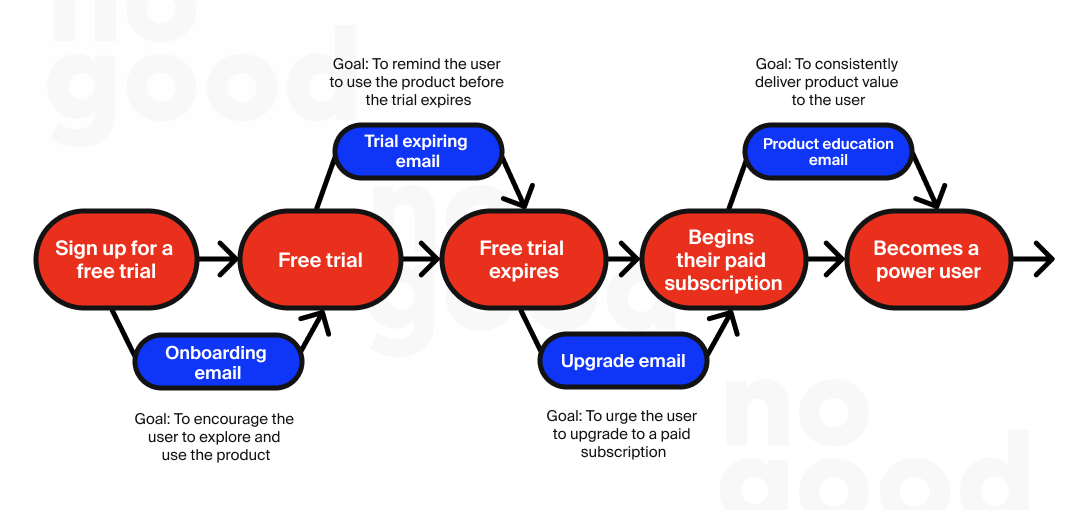
No two user journeys are completely the same (which is why mapping out the user journey is key), but as a starting point, let’s go over 4 of the most common email flow types across both the free trial and freemium SaaS models.
1. The onboarding flow
First impressions matter, particularly in a highly competitive SaaS market. The onboarding email is the company’s first touchpoint with a new lead, representing an opportunity to make a good impression and set up a solid foundation for continued engagement. An onboarding email should welcome the user to the product and the brand, provide easy steps to help them get started, and facilitate a basic understanding of how to use the product. The goal of the onboarding flow is not to immediately convert them to a paid user, but rather provide them with opportunities to engage with the product, so that they can realize the value that the product can provide through experiencing it first-hand.
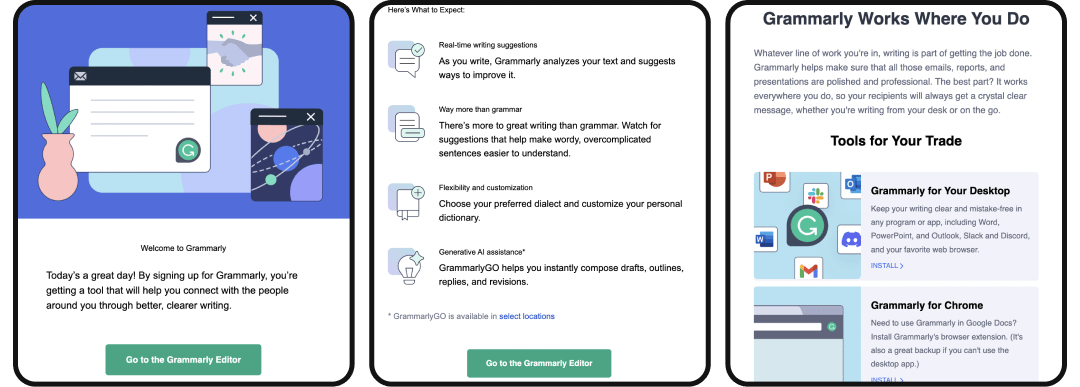
In Grammarly’s onboarding flow, they gave a simple introduction to the product and brand, gave a bulleted overview of what the product can do, and provided suggestions for desktop and Chrome integrations. Introducing potential integrations as part of an onboarding flow is an excellent strategy because it increases the number of potential ways in which a user can interact with the product. Since the goal of the onboarding flow is to drive engagement, the more opportunities the user has to use the product, the better.
2. The trial expiring flow
The duration of a free trial or a limited freemium period is essentially the user’s evaluation period, during which the user makes a decision, based on their experiences with the product, on whether or not the value it provides is worth its price. On one hand, the trial expiring flow creates a sense of urgency by reminding the user that they have a limited amount of time or actions before they would have to make a decision. On the other hand, the trial expiring flow is also a valuable way for the brand to quell any lingering doubts that the user may have about the product. Building this user trust can be done through onboarding tools, product walkthroughs, tutorials, or even 1-on-1 expert help.

Squarespace’s trial expiring flow strikes the perfect balance between urgency and patience. The beginning and end of the email feature a clear primary CTA that pushes the user to sign up for a paid subscription, while the main body of the email offers different ways for the user to find out more about the product. Knowing that users at this stage of their journey are still in the process of making a decision, Squarespace strategically provides marketing tools, help guides, third-party extensions, and expert help to guide the user to their next step.
3. The upgrade flow
The upgrade flow is what most people immediately think of when it comes to email marketing for SaaS. Assuming that the user has already gone through their discovery, engagement, and evaluation phases through earlier flows, the upgrade flow becomes the point at which the user makes the decision to either upgrade or cancel their subscription.
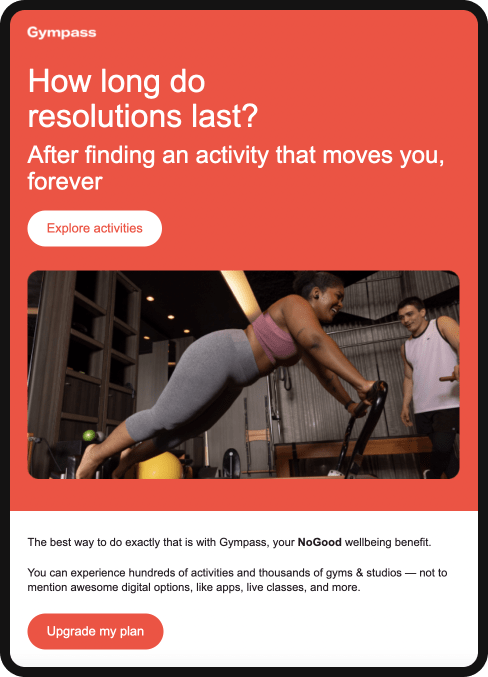
Like Gympass’ upgrade email, the upgrade flow should ideally be concise, straightforward, action-oriented. At this point in the journey, if done correctly, the user should have sufficient information about the product to make an informed decision on whether or not they want to upgrade their plan. Upgrade emails should include large, clear CTAs above the fold, and provide immediate information on what the user can expect to get out of the upgrade.
4. Product education emails
When it comes to email marketing for SaaS, the work doesn’t end once the user signs up for a paid subscription — in fact, that is often where the real challenge begins. The average monthly churn rate for SaaS products is 3-8%, meaning that companies need to develop robust retention strategies to maintain and grow their user base over time. Product education flows are a good way for SaaS companies to maintain consistent communication with their user base, making sure that they are regularly engaging with the product and are deriving real value from their subscription.
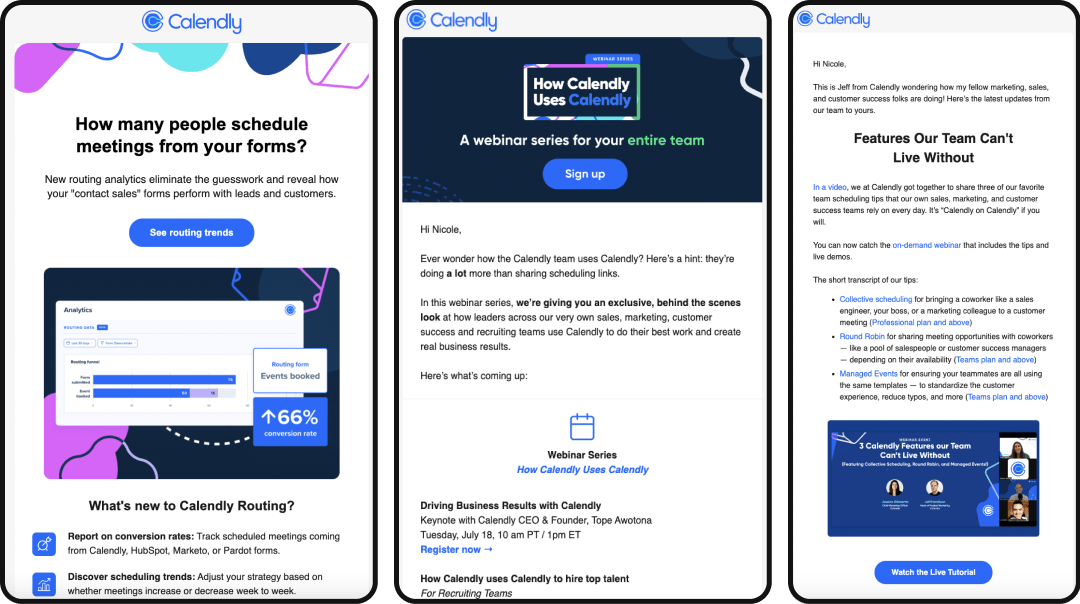
Product education emails are a great way to make sure that your user base is in the know about all the latest product updates and how each feature can benefit them. For example, Calendly sends monthly product newsletters about all the latest features that users may find helpful. These emails can range from tutorials, to webinars, to events and more — the key is to get the user to engage with the product on a regular basis.
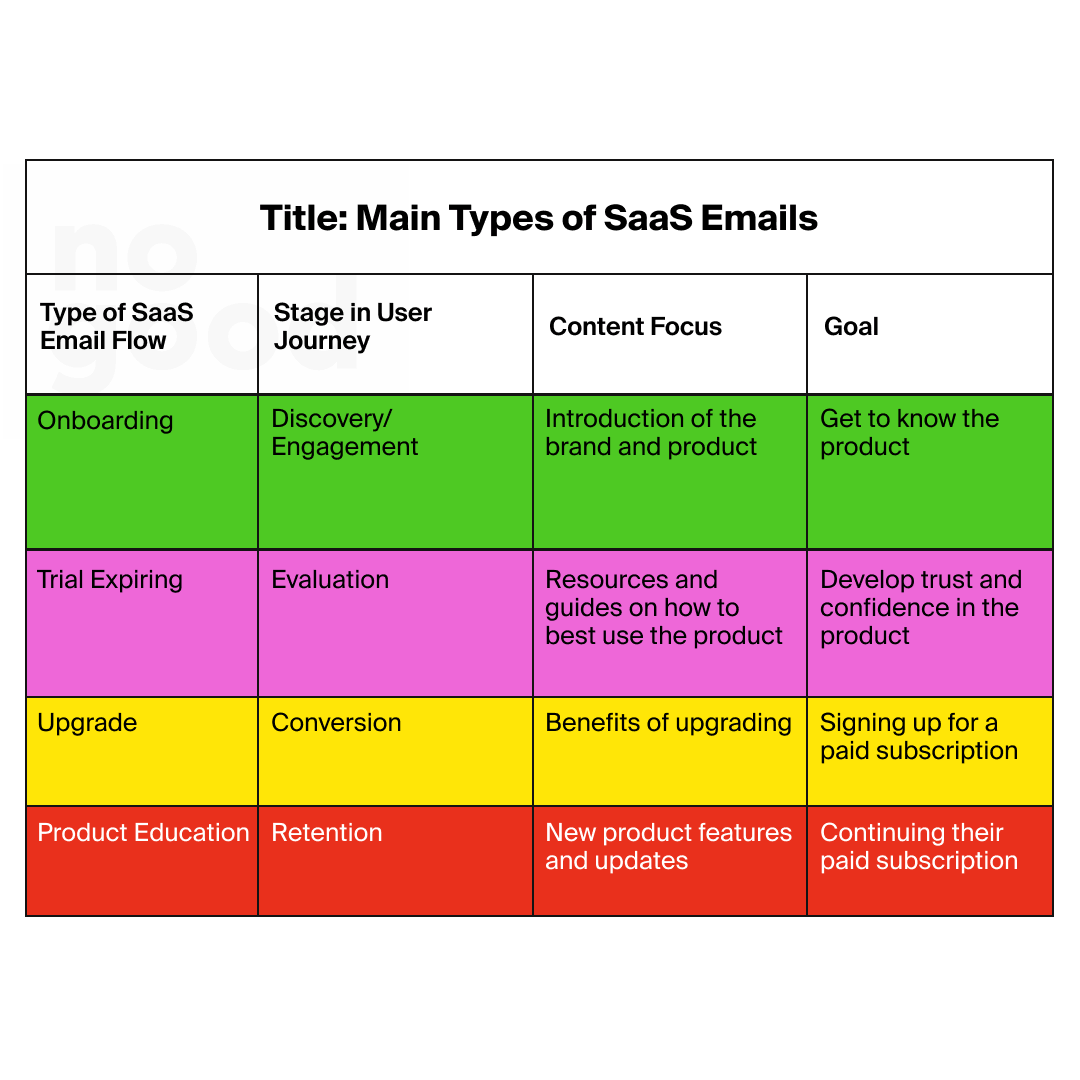
9 Email marketing for Saas Strategies
Now that we’ve covered the foundation of email marketing for SaaS, here are 9 of the most impactful strategies for increasing high-value, qualified product sign-ups.
1. Segmented behavioral triggers
One size doesn’t fit all, so why should email flows be one-to-all? Aside from the initial welcome or onboarding flow, successful SaaS companies often use behavioral triggers to send different promotional emails to different segments of users, based on which parts of the product they’ve interacted (or have yet to interact) with. For example, Clickup sends separate emails for specific product features such as @amentions, Clickup Inbox, or Conditional Logic in Forms. Since Clickup has access to user data on which parts of the product they’ve interacted with, they can send segmented emails to push users to explore parts of the product they haven’t yet seen the value of.
Sample behavioral triggers might look like “send an email to users who have been active in the last 7 days but have not clicked on the Clickup Inbox”. This essentially ensures that you are delivering product recommendations that are actually relevant to the user and are not redundant with actions they’ve already taken.
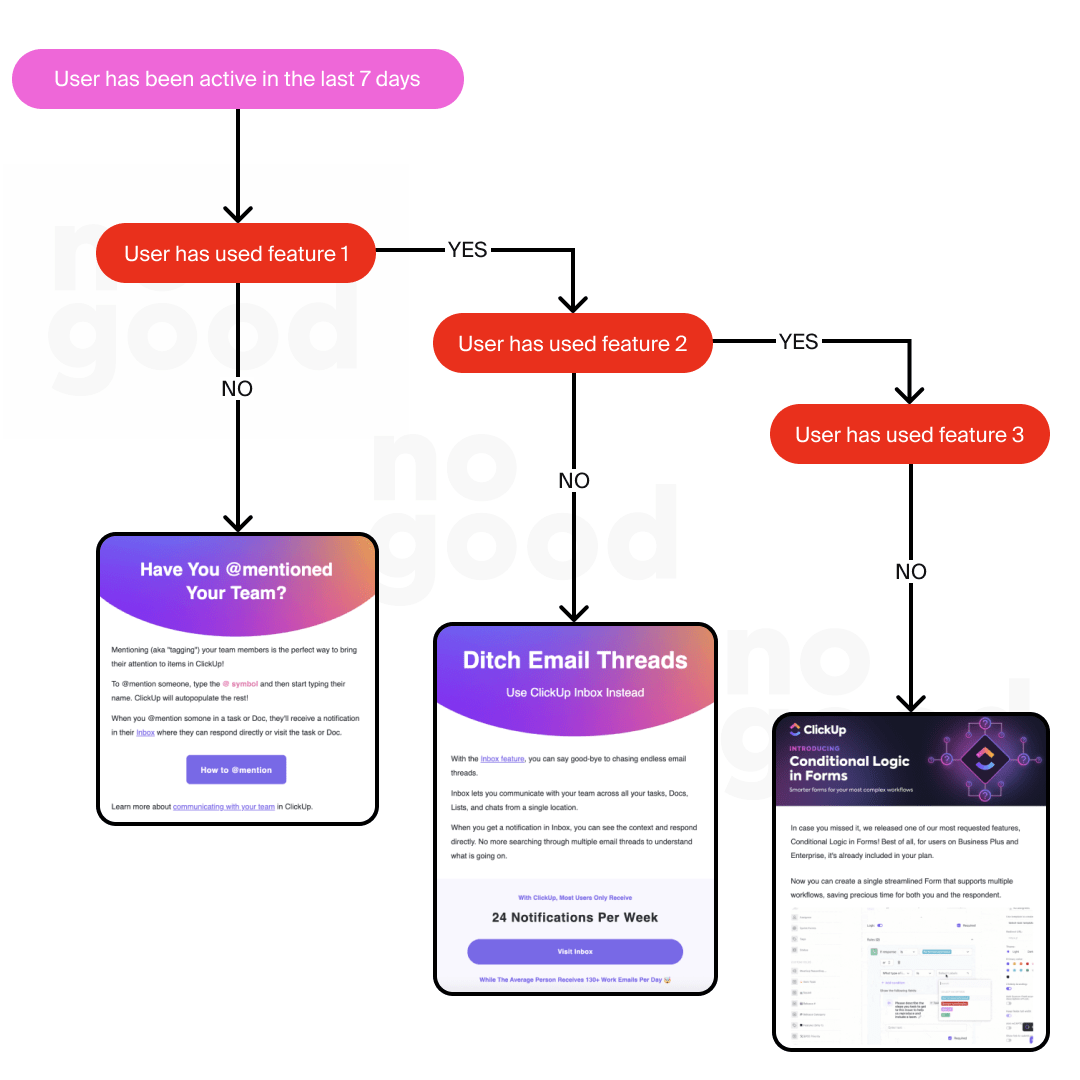
2. User data story
Aside from segmented behavioral triggers, another way to leverage SaaS user data for email marketing is through telling user data stories. Oftentimes it is difficult for users to quantify how much value they are getting out of a SaaS product, so visualizing and communicating that value to them through their user data can help clarify that value.
For example, Grammarly does this by grading users on their productivity, mastery, and vocabulary compared to other Grammarly users and shows users the top 7 tones detected in their writing over the course of the past week. This type of user data story gives users insight into their writing that they wouldn’t otherwise have without Grammarly, incentivizing them to stick with the product to continue improving their writing skills and tone.
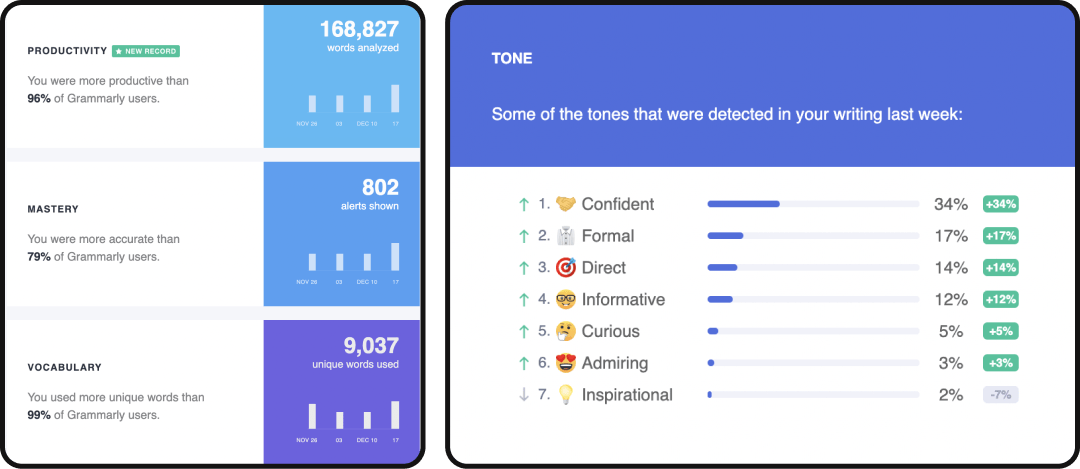
3. Micro-conversions
Micro-conversions are small, easy, tangible actions that users can take before making the decision to upgrade to a paid subscription. Micro-conversions can include actions like watching a product demo, downloading a guide, or filling out a survey. For example, Honeybook encourages micro-conversions by offering free ChatGPT prompts or templates for users to use. By leveraging email campaigns that strategically target these micro-conversions, SaaS companies can nurture a more engaged and informed user base.
These incremental actions indicate user interest and present opportunities to tailor subsequent communications. Crafting personalized, relevant content addressing specific user behaviors or preferences showcased through these micro-conversions enables SaaS companies to guide prospects and users toward fuller engagement, paving the way for eventual macro-conversions and heightened customer retention.
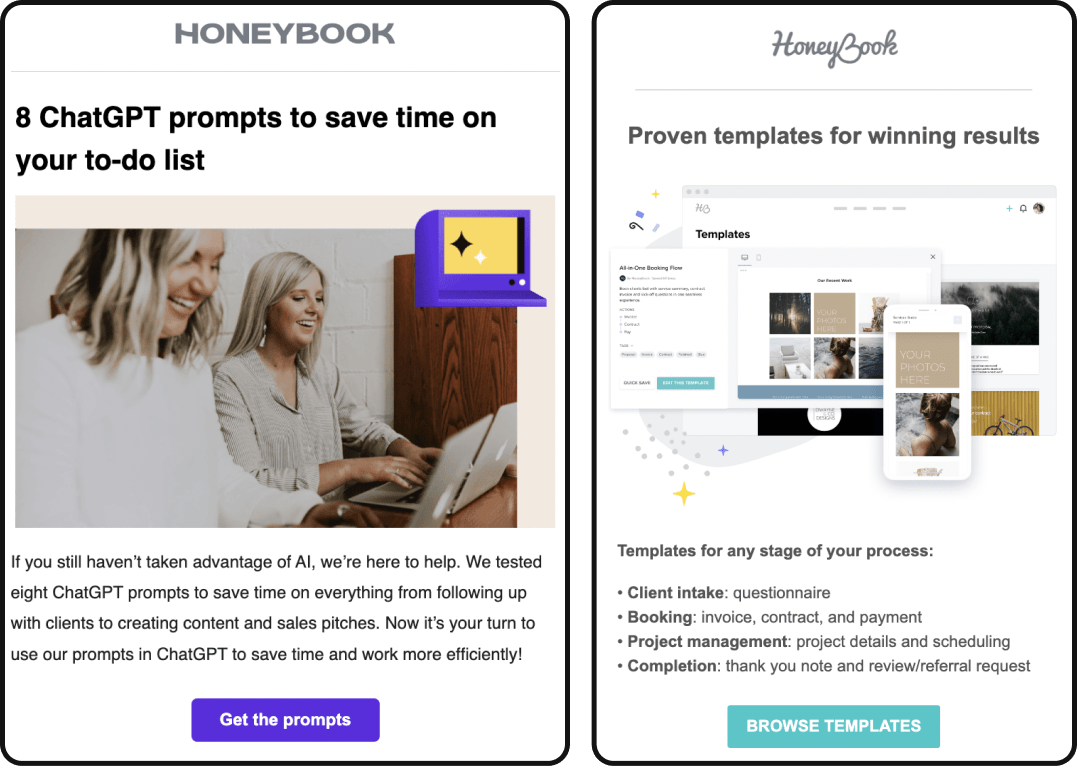
4. Zero-party data collection
Unlike third-party data, which can be limited and sometimes unreliable, zero-party data is willingly shared by customers themselves, offering a goldmine of valuable information. For SaaS businesses, this data is usually directly provided by users through surveys, quizzes, preference centers, and feedback forms. Utilizing zero-party data in email marketing for SaaS enables tailored, hyper-personalized communication. Understanding customers’ preferences, pain points, and specific needs and tying those data points to specific email addresses allows for highly targeted email campaigns, leading to increased relevance, engagement, and, ultimately, higher conversion rates.
For example, business management software Bonsai starts their user sign-up process with a question asking what kind of work the user does. Based on their answer, whether it be acting, animation or architecture, Bonsai can then send personalized emails that highlight the specific use cases that would be relevant to that user.
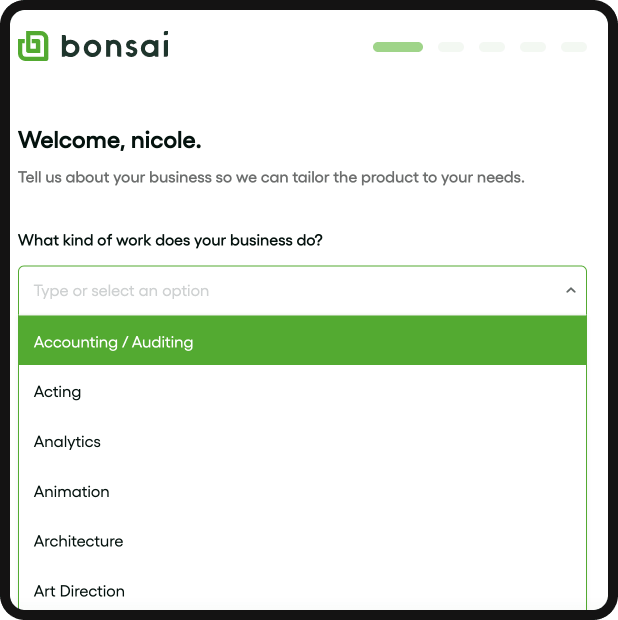
5. Onboarding checklists
Implementing an onboarding checklist within an email flow stands out as an invaluable strategy for SaaS businesses aiming to streamline user experience and maximize engagement. This dynamic approach not only guides users through the initial stages but also adapts to their progress. By incorporating a comprehensive checklist directly into email sequences, SaaS companies can offer a structured pathway for users to navigate through different features or steps in their journey. The brilliance lies in its adaptability – the email flow can intelligently update the checklist based on the user’s actions or inactions.
This personalized approach ensures that users receive tailored guidance, nudges, or reminders, keeping them on track toward achieving their goals within the platform. As users complete tasks or milestones, the checklist dynamically adjusts, presenting a sense of accomplishment while encouraging further exploration. Ultimately, this interactive and responsive onboarding checklist embedded within email campaigns enhances user engagement, minimizes drop-offs, and fosters a positive onboarding experience, which is crucial for SaaS businesses aiming for long-term user retention and customer satisfaction.
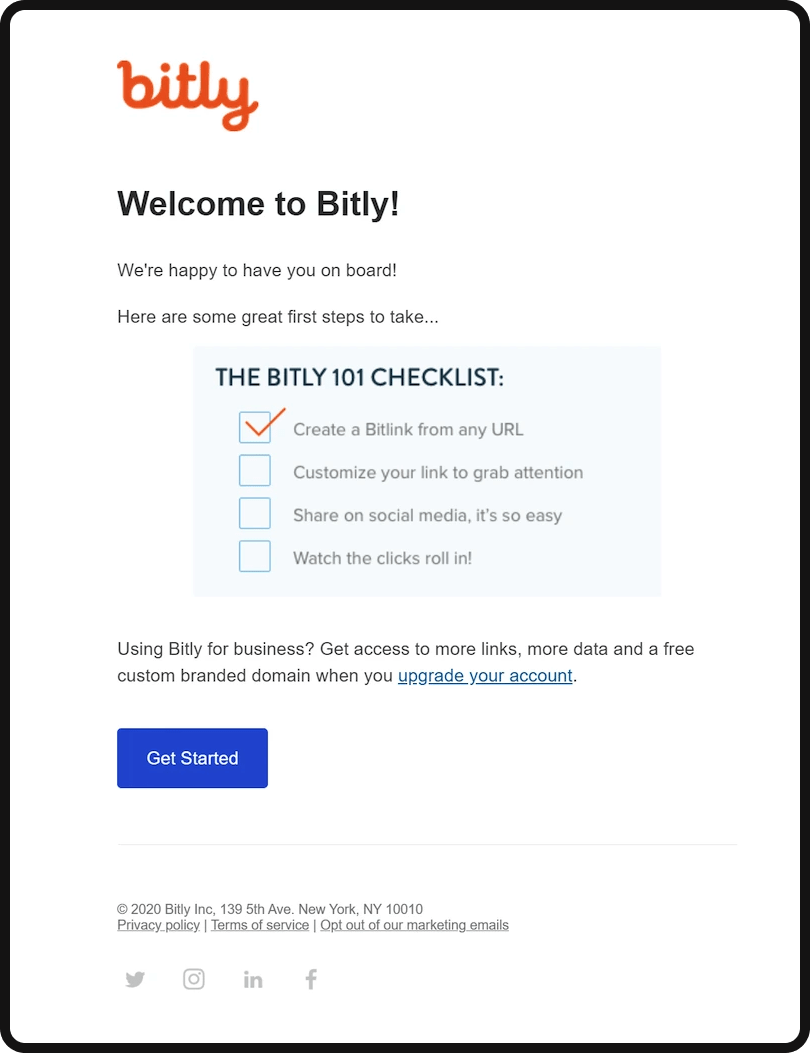
7. A/B Testing
A/B testing allows these companies to experiment with variations in email content, subject lines, visuals, calls-to-action, or sending times to determine what resonates best with their audience. By splitting the email list into distinct segments and sending different versions, SaaS marketers can gather invaluable insights into user preferences, behaviors, and conversion rates.
This data-driven approach helps refine and tailor future email campaigns (promotional and transactional emails) based on concrete evidence rather than assumptions. Whether it’s testing the efficacy of a persuasive subject line or evaluating the impact of different layouts, A/B testing empowers SaaS businesses to make informed decisions, improve open and click-through rates, and ultimately drive conversions.
8. UGC and use cases
Incorporating user-generated content (UGC) and real-life user stories within email marketing campaigns stands as an impactful strategy for SaaS businesses to showcase the tangible value and practical applications of their products. By featuring authentic experiences and success stories from actual users, these emails humanize the SaaS product, instilling trust and credibility in potential customers.
For example, Notion sends an email to new users demonstrating “4 most popular ways Notion is used, and the difference it’s made for 4 real humans”. By tying each use case to a real, user-created setup, the email provides social proof, allowing prospects to visualize themselves experiencing similar benefits. Moreover, integrating UGC and user stories into email campaigns creates a relatable narrative that speaks directly to the pain points and aspirations of the target audience.
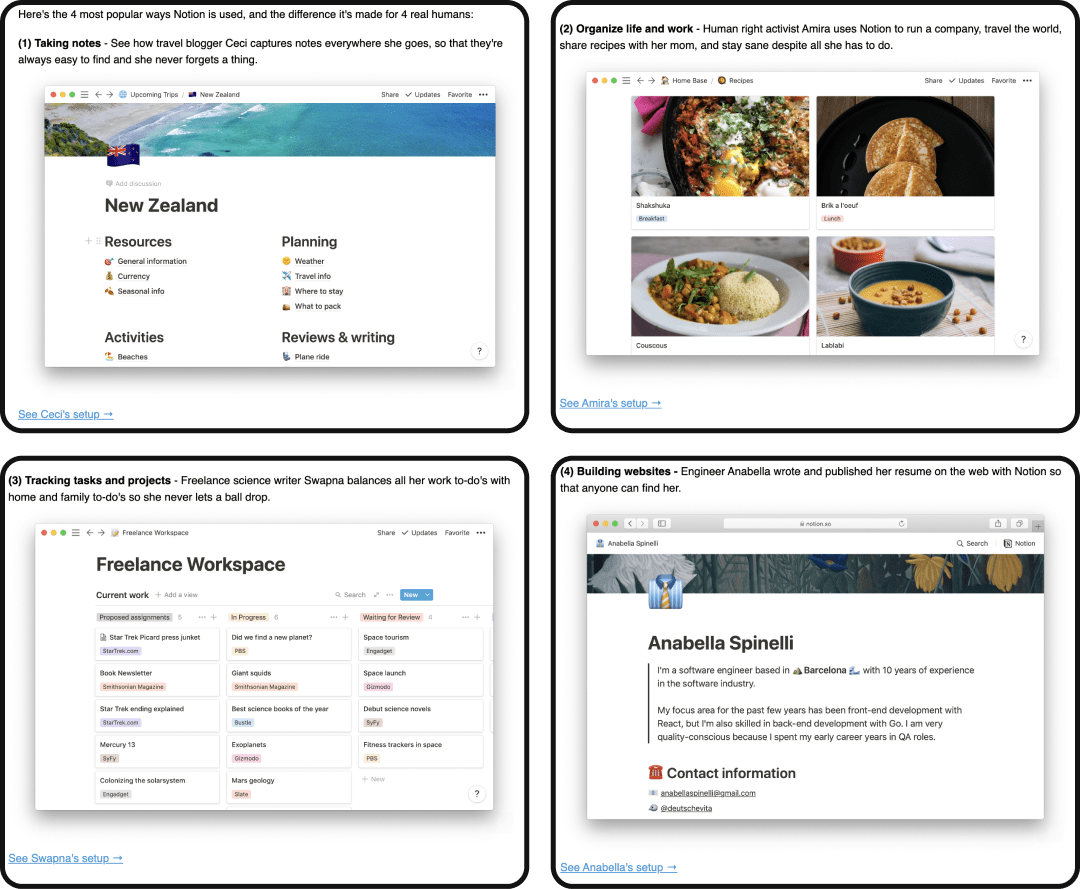
9. Customer feedback collection
Soliciting feedback via email enables SaaS companies to gain firsthand insights into user experiences, pain points, and desires, fostering a customer-centric approach to product development and refinement. It’s essential to request feedback from a diverse pool of users, including loyal users, recently inactive users, active new users, and even churned customers. Each cohort provides unique perspectives that contribute to a comprehensive understanding of the product’s strengths and areas for improvement.
Engaging with these different user segments through tailored feedback requests via email ensures a well-rounded view of the SaaS product’s performance across various stages of the user journey. By actively seeking and attentively listening to user feedback, SaaS businesses can identify patterns, prioritize feature enhancements, and pivot strategies to align more closely with user expectations.
These 9 strategies should set you up for success to start seeing measurable sign-up growth for your SaaS product. If you’re ready to level up your email marketing strategy for your SaaS business, we’re always here to help.



